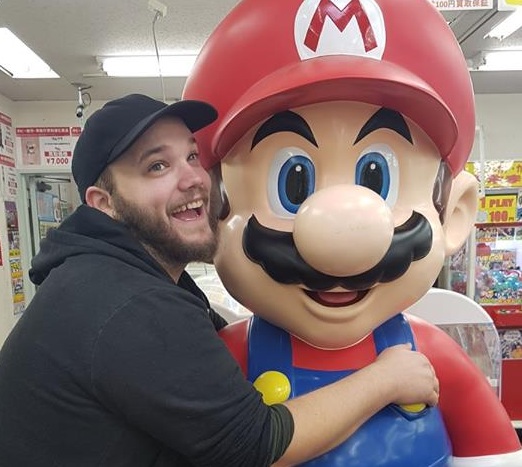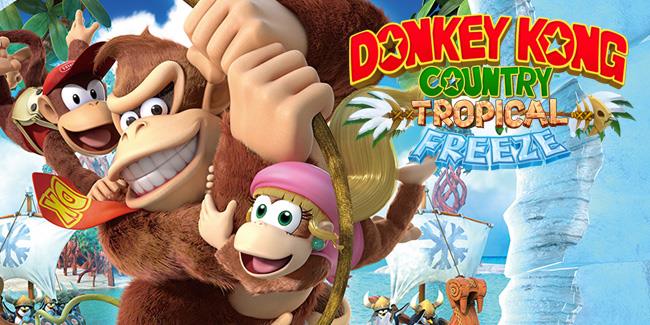
Nintendo’s in full swing for rehashing old franchises for the Wii-U because nothing says “next-gen” like re-polished games from yesteryear. February brought us Donkey Kong: Tropical Freeze, which is actually somewhat of a misnomer given that the “Freeze” part of the title doesn’t really enter into gameplay until towards the end of the game. I’m disappointed, to say the least, because I had been really looking forward to this game and what it turned out to be is not what I had expected. I was hoping for a big change in the Donkey Kong dynamic that would introduce new environments and mechanics to enhance what was a solid, if perhaps a little old, design.
However, it almost felt as if Nintendo had promptly read my dream journal, took careful notes about what I was hoping for, and then took every effort not to include it in the game. In truth, that actually worked out in some respects, but in others, it meant that the game couldn’t live up to the legacy of its predecessors reputations.

First party Nintendo games are always a bit of a mixed bag when it comes to storytelling; sometimes it can be great, sometimes it can be incredibly sparse, and other times the story is there, but the game doesn’t outright tell you. Much like Super Mario 3D World, Tropical Freeze is very much the latter. The framework is all there for a story to be told, but the game never really gets around to it. The game starts out with Donkey Kong and co. celebrating what looks to be Donkey Kong’s birthday when it’s rudely interrupted by a snowflake ruining DK’s birthday cake, something which triggers what to me seemed like a disproportionate amount of anger in our simian hero.
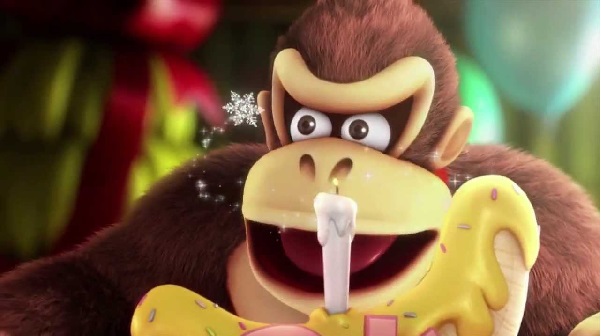
Subsequently, they all run outside to find an army of snow Vikings, “creatively” named the Snomads, knocking on their proverbial door with a not-so-proverbial giant ice dragon. In turn, they all get blown off to some other part of the archipelago and, naturally, they have to fight their way through numberless hordes in order to reclaim their home. One thing that Donkey Kong has accomplished over Mario is the fact that the protagonists motivation at least appears pretty clear: their home is stolen, and they want to get it back (as opposed to just fighting out of reflex without any sort of exposition). What isn’t clear is why the Snomads wanted DK Island in the first place, since the game decides it’s unnecessary plot information, and disregards anything even close to an explanation.
Essentially, the game introduces an entirely new group of bad guys for players to fight their way through, which was a good change, but then fails to provide any sort of backstory, substance, or even any information about who they were. We don’t even learn their names until Funky Kong tells us “those gnarly Snomads are really enjoying your island, Donkey!”. So I guess that the lasting impression the game wanted us to have of the Snomads is they’re particularly aggressive and invasive freeloaders? They aren’t there to steal something from DK Island, they don’t even appear to have many aspirations within the archipelago beyond “hanging around inconveniently placed locations.” You might think that, being a platformer, the game only really needs to provide a baseline story just to move the action along, but it’s still the same premise for just about every DK-platformer that’s ever been released.
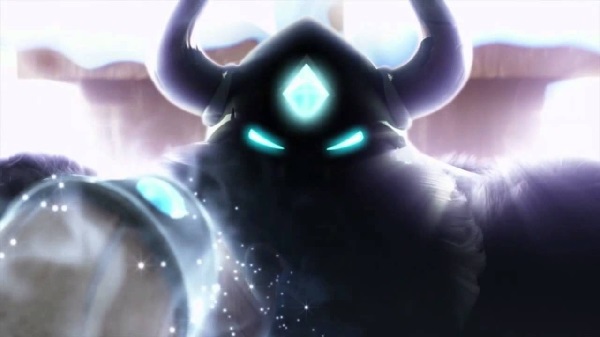
In fact, I would go as far as to suggest that Donkey Konga had a more interesting setup than this game; for which the narrative premise was that Donkey and Diddy had found some bongo barrels, and Cranky told them that they were awful musicians. Like Mario, Donkey Kong:Tropical Freeze just lazily assumes that we’ve all been on this ride before and that we should just be quiet and enjoy another, very similar, iteration of the same thing we’ve been playing for the last twenty years. Even though it was enough to move the story along and deliver exactly what you’d expect, the ending left me feeling unfulfilled since it was basic enough to be summed up in a single sentence: “Donkey Kong has his island stolen, he beats people up, then gets it back.” What a thrill, Nintendo.
For a platform-adventure game, the design isn’t exactly adventurous, and if you’ve played Donkey Kong Country Returns, then you’ve already experienced about two thirds of the content. In my opinion, the level design felt as if both came from the same drawing board, in fact, the first island segments might as well have been pulled from the game and released on their own as a “DKC Returns Remix” mini-game. The similarity in the games is even more stark when you consider that there is supposed to be an ice theme throughout the game. Having a few tropical levels at the beginning of the game might have been a great tutorial to introduce players into a new environment, but barely reflecting your core narrative theme in the game’s design makes things feel a little disjointed. It creates an expectation for the player of what to expect and then doesn’t deliver, which for me was a bit of a let down.
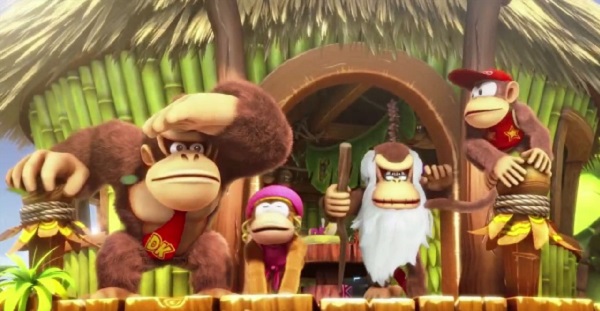
“… Plot holes…”
The game still performs exceedingly well in some areas, like rewarding player exploration the way that a game should do: with more gameplay. The levels that could only be accessed via the secret goal markers were definitely the most fun to play, as well as some of the especially challenging levels, making it feel like that much more of an accomplishment. They aren’t few and far between either, and there aren’t exactly easy to unlock. It also means that there’s enough content on each island to satisfy players who want quite a lot out of the game, and also a linear and relatively quick “default path” for more casual players who may not have as much time to invest. It’s an intelligent world design that caters to a range of players in Nintendo’s audience, proving that they’re paying attention to player feedback and understanding that game design has to treat the two as being mutually exclusive.
The levels themselves, while not exactly feeling “inspired”, are still fun and enjoyable to play; just because we’ve seen most of it before, the content that was fun in previous games is still fun now. It wouldn’t make sense not to include at least some of the design aspects in the new game that were proven to be successful in the previous one. Tropical Freeze’s problem is that it doesn’t have enough of its own ideas to keep it interesting. A lot of great ideas for single levels are introduced and are never seen again, like the mine cart level that switches to a birds eye perspective and has you dodging obstacles between three rail lines. That stage was great to play, which makes me wonder why they didn’t try to introduce other new ideas to help create a more distinct identity for the game.

“Audible gasp! A metaphor!”
The game’s pacing stayed very much the same throughout; instead of feeling as though it was leading toward something bigger, Tropical Freeze started out strong and then decided as a reward it would drag on like that for the rest of the game. I’d receive a taste of something exciting or challenging every couple of stages, but then it would send me straight back into the same kind of platforming levels that make up the greater majority of the game. It’s as though the game was afraid to let me have too much fun, perhaps fearing I’d reach the halfway mark, feel all “funned out” and not finish the game. As it stands, I found that this restricting and occasionally stop-start pace made it kind of a struggle just finishing the game. I want to go back and finish 100% completion because there certainly is a lot of gameplay to be had, but having to jump around to stages with no curve on which to place their difficulty, in order to get those items which are already supposed to be hard to obtain, sounds exhausting.
There might not have been as many ice levels as the title suggests, but the way DK moves could fool you into thinking otherwise. His movement is quite lumbering,and mastering his controls can take quite a bit of practice, especially when he can apparently defy the laws of physics. Jumping while running to get more distance has been a staple of platforming games since the SNES era, and it holds true here. However, jumping out of a forward roll causes DK spontaneously to grow booster jets that will launch him at speeds which are deceptively disproportionate to how fast you were moving just prior. There were more than a few times when I would die immediately after respawning as I would misjudge how far DK would hurl himself and fly off into an open abyss.

The new playable characters which were added into Tropical Freeze provided great gameplay with frustrating limitations. The control scheme for each of the controllers was fine, except for having to shake the Wii-mote to roll your character, which was disruptive when trying to move. However, one player always has to be DK, and if you’re playing single player then that means you’re chiefly controlling him. The companion Kongs will jump on DK’s back in single player and lend them their different abilities, but you’re still always controlling, jumping, and operating DK. In multiplayer, this is a problem as the other characters are all much more nimble and agile than DK, and the second player has to wait for the slower and less adept DK to catch up. This is the perfect storm for frustrating multiplayer gameplay, when you end up dying because you were delayed in a dangerous area by your partner.
The design of the levels may not have always been incredibly varied, but they still presented a decent challenge while playing. Some of the individual levels (several of which took many continues and frustrated cursing for me to pass) were of an above average difficulty, and were also a great test of the player ability. Additionally, finding the collectibles or secret areas were challenging for the treasure-hunting fun it provided. However, there were also occasions where the difficulty of the game needlessly spiked up and demanded that you either climb the difficulty curve or continuously game over. If you’re playing single player, however, this will usually just lead to losing a few dozen lives for each stage, in a cycle of constant dying and respawning that taught me entirely new ways to hate.
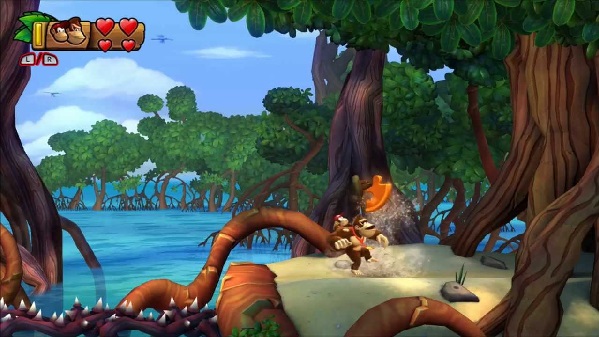
With that being said, at other times in the game, it almost felt as if Tropical Freeze was too easy; allowing the player too many chances to make mistakes with little to no consequence. Between the extra hit points for Donkey Kong, items like invulnerability potions, extra hit points from your partner-Kong, mid-stage checkpoints, and even further hit points that can be bought from Funky, you tend to hit the max level cap pretty quickly (it’s 99, by the way). It can feel oddly freeing at times since the puzzle pieces, arguably more difficult to obtain than the KONG letters, remain in your possession after you’ve gotten them, even if you die. So, you might see one mid-stage and leap to your death just to grab it, knowing that you’ll just re-do that last part but now with a puzzle piece in tow.
The overall impression I got from Donkey Kong: Tropical Freeze is that the way it looked and felt were totally separate from how it sounded. The original Donkey Kong Country games had great soundtracks to match the “dark” vibe that was a constant undertone of the games environment. It made the place feel exotic, dangerous, like you were really on an exciting adventure and my memories of playing it as a kid are still with me today. Listen to the underwater track from the original Donkey Kong Country game here, and then listen to a version of that same track from the Tropical Freeze OST here. The music is obviously of better quality because the technology is better, but they still maintain that same feeling from the original soundtrack. It was completely unexpected for me to take notice of the soundtrack in a game since it’s something I rarely do, but it is actually really, really great. It’s so great.
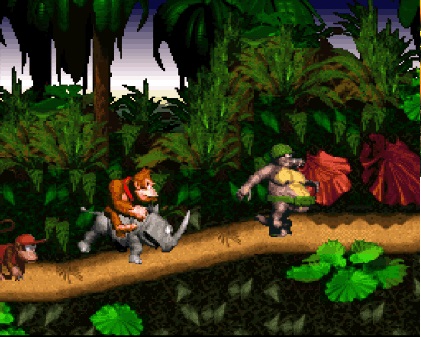
From all 16 sexy bits of this…

… to DK and Cranky Kong activating unspeakable powers in Hi-Def.
Now, if you were to look at a side by side comparison of Donkey Kong Country for the SNES and Donkey Kong Country: Tropical Freeze (pictured above), you can see how much the games’ appearance has improved over the years. The improvement is even more stark when you consider that the franchise has maintained its distinctive, side-scrolling platformer design, allowing players a benchmark by which to assess that improvement. As such, it can’t be argued that, graphically, the game has accomplished quite a lot in terms of performance and appearance. I’ve said before that the first party Nintendo titles which have been recently released are beginning to resemble, possibly rival, Disney levels of visual style. However, in saying that, it’s also an issue for the overall feeling of the game, because the newer graphics are very light and cheerful, and not at all reflective of the dark atmosphere to which the music alludes the player. It’s like walking into a Disney film with music by Tim Burton; everyone wants to be cheerful, but there’s this constant crooning over the top that’s trying to make everyone as dreary as it feels.
It isn’t that the game has particularly bad graphics or terrible music since both individually are pretty great, it’s just that they don’t match well. It’s as though there was some debate among the art and music teams about whether or not they were going to get on board with a return to the feeling from the old games. Somewhere along the line they just decided to do their own thing, and the result left me feeling a bit disjointed while playing the game.
 Excellent soundtrack
Excellent soundtrack Detailed and uniquely stylised graphics
Detailed and uniquely stylised graphics Great challenge in gameplay
Great challenge in gameplay Robustly diverse world-map
Robustly diverse world-map Replayability for 100% completion
Replayability for 100% completion
 Tired, over-used or re-used level designs
Tired, over-used or re-used level designs Difficult curve resembles Richter reports
Difficult curve resembles Richter reports Occasional unmanageable controls
Occasional unmanageable controls Bad audio/visual combination
Bad audio/visual combination Basic, unfulfilling narrative premise
Basic, unfulfilling narrative premise
There were so many excellent parts to this game that, otherwise, just didn’t fit together, and likely because they were prevented from grooving together by all of the forced nostalgia that was crammed in. It tried too hard to cling to “tried and true” methods, regardless of whether or not they fit in with the rest of the game, or were under-developed for what they were supposed to accomplish. It was still fun to play, but probably not as much as it was the first time we played it as Donkey Kong Country Returns. Tropical Freeze isn’t a bad game, by the standards of most platformers that get released these days, it’s above average. For all its faults, it still delivered challenging platforming, which is mission accomplished on at least providing the core of what a platforming game should be.
The problem here isn’t necessarily with the game, however.In fact, i’d argue that it’s with Nintendo, who appear to have forgotten somewhere along the line that constantly repackaging the same IP’s over and over again doesn’t work if you don’t at least try to change things up a bit from time to time. They’ve been using the same base design of a game from nearly 20 years ago for every game in the franchise, and it’s becoming clear that you can’t “jazz things up” with one or two new features per title and expect the magic to happen… With a few changes in the design of the game, Tropical Freeze could have been a whole lot more than it was; instead it seemed like the development team fell short while trying to overstretch to cater for what they thought the players would want.

